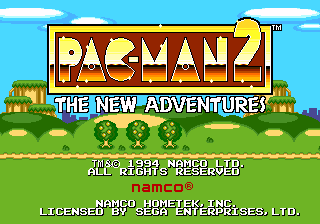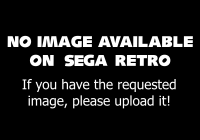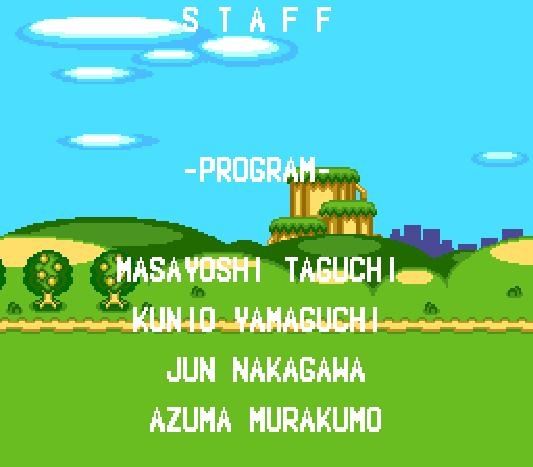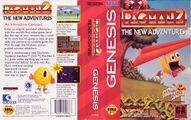Difference between revisions of "Pac-Man 2: The New Adventures"
From Sega Retro
m |
|||
| (7 intermediate revisions by 5 users not shown) | |||
| Line 1: | Line 1: | ||
{{Bob | {{Bob | ||
| bobscreen=PacMan2 Title.png | | bobscreen=PacMan2 Title.png | ||
| − | | publisher={{company|[[Namco]]}}, {{company|[[Ballistic]]|region=Re-releases}} | + | | publisher={{company|[[Namco Hometek]]}}, {{company|[[Ballistic]]|region=Re-releases}} |
| developer=[[Namco]] | | developer=[[Namco]] | ||
| system=[[Sega Mega Drive]] | | system=[[Sega Mega Drive]] | ||
| Line 17: | Line 17: | ||
{{SaveType | {{SaveType | ||
|MD|password | |MD|password | ||
| − | }}}} | + | }} |
| + | }} | ||
'''''{{PAGENAME}}''''' is a [[Sega Mega Drive]] [[wikipedia:adventure game#Point-and-click adventure games|point-and-click]] graphic adventure game developed and published by [[Namco]]. A spin-off of the company's renowned ''[[wikipedia:Pac-Man (video game)|Pac-Man]]'' series, it was released exclusively in the United States in November 1994, and later received a pair of American re-releases courtesy of publisher [[Ballistic]]. | '''''{{PAGENAME}}''''' is a [[Sega Mega Drive]] [[wikipedia:adventure game#Point-and-click adventure games|point-and-click]] graphic adventure game developed and published by [[Namco]]. A spin-off of the company's renowned ''[[wikipedia:Pac-Man (video game)|Pac-Man]]'' series, it was released exclusively in the United States in November 1994, and later received a pair of American re-releases courtesy of publisher [[Ballistic]]. | ||
| − | The game was first released on the [[Super Famicom]] as ''Hello! Pac-Man'' (ハロー! パックマン) in Japan and was advertised in a charming and appropriate manner. When it was brought to the West, it was localized and marketed as a true sequel to the original ''Pac-Man'' - attempting to downplay the game's unique genre and increase sales. However, this also colored buyer's expectations for a game which resembled the arcade original, and subsequently contributed to ''{{PAGENAME}}'''s notoriously-poor reception in English-speaking countries. Regardless, the game has seen a modern re-evaluation, and is generally considered one of the more unique and interesting examples in the point-and-click adventure game genre. | + | The game was first released on the [[Super Famicom]] as '''''Hello! Pac-Man''''' (ハロー! パックマン) in Japan and was advertised in a charming and appropriate manner. When it was brought to the West, it was localized and marketed as a true sequel to the original ''Pac-Man'' - attempting to downplay the game's unique genre and increase sales. However, this also colored buyer's expectations for a game which resembled the arcade original, and subsequently contributed to ''{{PAGENAME}}'''s notoriously-poor reception in English-speaking countries. Regardless, the game has seen a modern re-evaluation, and is generally considered one of the more unique and interesting examples in the point-and-click adventure game genre. |
==Story== | ==Story== | ||
| Line 60: | Line 61: | ||
| screenshot=Notavailable.svg | | screenshot=Notavailable.svg | ||
| desc=After returning home from Pac-City, Pac-Man learns from a news broadcast that the ghosts are stealing bubblegum from children all over Pac-City. The Ghost Witch of Netor suddenly hijacks the airwaves, challenging Pac-Man to face her and her newest creation, the Gum Monster. The player must guide Pac-Man through the abandoned factory where the Gum Monster is being created, and defeat it using Super Pac-Man. | | desc=After returning home from Pac-City, Pac-Man learns from a news broadcast that the ghosts are stealing bubblegum from children all over Pac-City. The Ghost Witch of Netor suddenly hijacks the airwaves, challenging Pac-Man to face her and her newest creation, the Gum Monster. The player must guide Pac-Man through the abandoned factory where the Gum Monster is being created, and defeat it using Super Pac-Man. | ||
| + | }} | ||
| + | }} | ||
| + | |||
| + | ==Production credits== | ||
| + | {{multicol| | ||
| + | {{creditstable| | ||
| + | *'''Program:''' Masayoshi Taguchi, Kunio Yamaguchi, Jun Nakagawa, Azuma Murakumo | ||
| + | *'''Visual Design:''' Nekomoto Rita and Graphic Team | ||
| + | *'''Sound:''' Fuken Tajima, Zun, {{rolloverText|Kawagen|Yoshinori Kawamoto}}, Shibanon, Polykome | ||
| + | *'''Original Game Staff:''' Yumi., Chitose, Roki.-, Katze Kitasan, Nekomoto Rita, Sirohsan, Kappappa Sakaki, Hang Chang, Beanbe, Hirapon, Honiho, Yuki, Sakura Saita, Ousaru, Tsukasa, Takayan, Fuken Tajima, Kazuu | ||
| + | | source=In-game credits | ||
| + | | pdf=Pac-Man 2 MD credits.pdf | ||
| + | | console=MD | ||
}} | }} | ||
}} | }} | ||
| Line 111: | Line 125: | ||
==Technical information== | ==Technical information== | ||
| − | + | {{mainArticle|{{PAGENAME}}/Technical information}} | |
| − | {{ | ||
| − | {{ | ||
| − | }} | ||
==References== | ==References== | ||
Latest revision as of 04:28, 27 May 2024
| Pac-Man 2: The New Adventures | ||||||||||
|---|---|---|---|---|---|---|---|---|---|---|
| System(s): Sega Mega Drive | ||||||||||
| Publisher: Namco Hometek, Ballistic (Re-releases) | ||||||||||
| Developer: Namco | ||||||||||
| Sound driver: Namco sound driver | ||||||||||
| Genre: Adventure | ||||||||||
| Number of players: 1 | ||||||||||
| ||||||||||
| ||||||||||
Pac-Man 2: The New Adventures is a Sega Mega Drive point-and-click graphic adventure game developed and published by Namco. A spin-off of the company's renowned Pac-Man series, it was released exclusively in the United States in November 1994, and later received a pair of American re-releases courtesy of publisher Ballistic.
The game was first released on the Super Famicom as Hello! Pac-Man (ハロー! パックマン) in Japan and was advertised in a charming and appropriate manner. When it was brought to the West, it was localized and marketed as a true sequel to the original Pac-Man - attempting to downplay the game's unique genre and increase sales. However, this also colored buyer's expectations for a game which resembled the arcade original, and subsequently contributed to Pac-Man 2: The New Adventures's notoriously-poor reception in English-speaking countries. Regardless, the game has seen a modern re-evaluation, and is generally considered one of the more unique and interesting examples in the point-and-click adventure game genre.
Contents
Story
The game follows an episodic approach where the plot unfolds through a loosely-connnected series of misadventures where Pac-Man must complete tasks for his family. Throughout these episodes, the ghosts and their mysterious leader, the Ghost Witch of Netor, plot to destroy Pac-Man by any means necessary.
Gameplay
Pac-Man 2: The New Adventures is an unusual entry in the series, as rather than being a top-down action game set in a maze, it is a side-scrolling adventure game. The player doesn't control Pac-Man directly, who instead wanders around the game world and interacts with objects and characters at his own pace. Rather, the game utilises a "Character Guidance Interface™"[1] which gives the player a slingshot, which they must use to guide Pac-Man around or have him interact with specific objects by using the D-Pad to move the cursor, and pressing ![]() to shoot; the longer
to shoot; the longer ![]() is held, the farther the bullet will be shot.
is held, the farther the bullet will be shot.
By guiding Pac-Man around, the player will need to solve puzzles to advance the plot. Over the course of the game, Pac-Man's mood can change, such as becoming happy when he eats an apple from a tree or becoming irritated or depressed when the player shoots him in the face, which is sometimes the solution to a puzzle. However, his mood can affect how co-operative he is with the player; for example, making Pac-Man grumpy will make him less likely to listen to the player.
From time to time, the ghosts (Blinky, Pinky, Inky and Clyde) will appear to harass Pac-Man, in turn causing him to become frightened and run around in a panic. Whenever this happens, the player has to feed him a Power Pellet using the ![]() button, which will transform him into Super Pac-Man and allow him to eat the ghosts. There are also scenes in which Pac-Man will ride a hang glider or a minecart, thus necessitating quick reactions from the player to get him to the end safely. There is no Game Over if Pac-Man gets knocked out; instead, the game restarts from the same location Pac-Man left off.
button, which will transform him into Super Pac-Man and allow him to eat the ghosts. There are also scenes in which Pac-Man will ride a hang glider or a minecart, thus necessitating quick reactions from the player to get him to the end safely. There is no Game Over if Pac-Man gets knocked out; instead, the game restarts from the same location Pac-Man left off.
The original Pac-Man arcade game is included in this game, and is accessed by visiting the arcade in Pac-City. By finding three cartridges, the player can unlock Pac-Jr. (Ms. Pac-Man in the SNES version).
Episodes
| The Practice Stage | |
|---|---|
| Taking place within the Pac-Family garden, this episode is a "cartoon short" intended to teach the player the basic rules of the game. Pac-Man will talk to the player directly, telling them what to do to interact with the game. | |
| Hunt & Gather | |
| Ms. Pac-Man has run out of milk for Pac-Baby, and Pac-Man must get some more milk by going to the local farm. The player must avoid waking the farmer, and have Pac-Man milk the cow and deliver the milk back home. | |
| Birthday Surprise | |
| Pac-Man is asked by Ms. Pac-Man to pick a special flower for Pac-Jr. to give to his friend Lucy for her birthday. Pac-Man is given a trolley ticket which he must use to venture into the nearby mountains, go hang-gliding and dodge ghosts and boulders as he searches for the flower. | |
| Rock 'n' Roll | |
| Pac-Jr.'s guitar has been stolen by ghosts while he was in Pac-City. Pac-Man is given a train ticket to travel to the city, where he meets a man selling balloons, and must take on a disgruntled security guard to get the guitar back. The ghosts are in a disguise, so the player should have Pac-Man check everyone he meets. | |
| Defeat the Ghost Witch | |
| After returning home from Pac-City, Pac-Man learns from a news broadcast that the ghosts are stealing bubblegum from children all over Pac-City. The Ghost Witch of Netor suddenly hijacks the airwaves, challenging Pac-Man to face her and her newest creation, the Gum Monster. The player must guide Pac-Man through the abandoned factory where the Gum Monster is being created, and defeat it using Super Pac-Man. |
Production credits
- Program: Masayoshi Taguchi, Kunio Yamaguchi, Jun Nakagawa, Azuma Murakumo
- Visual Design: Nekomoto Rita and Graphic Team
- Sound: Fuken Tajima, Zun, Kawagen, Shibanon, Polykome
- Original Game Staff: Yumi., Chitose, Roki.-, Katze Kitasan, Nekomoto Rita, Sirohsan, Kappappa Sakaki, Hang Chang, Beanbe, Hirapon, Honiho, Yuki, Sakura Saita, Ousaru, Tsukasa, Takayan, Fuken Tajima, Kazuu
Magazine articles
- Main article: Pac-Man 2: The New Adventures/Magazine articles.
Promotional material
also published in:
- Electronic Gaming Monthly (US) #65: "December 1994" (1994-xx-xx)[3]
- GamePro (US) #66: "January 1995" (199x-xx-xx)[4]
Physical scans
| Sega Retro Average | ||||||||||||||||||||||||
|---|---|---|---|---|---|---|---|---|---|---|---|---|---|---|---|---|---|---|---|---|---|---|---|---|
|
| 68 | |
|---|---|
| Based on 4 reviews | |
Technical information
- Main article: Pac-Man 2: The New Adventures/Technical information.
References
- ↑ File:Pacman 2 MD US Manual.pdf, page 3
- ↑ File:Pac-Man 2 MD credits.pdf
- ↑ Electronic Gaming Monthly, "December 1994" (US; 1994-xx-xx), page 207
- ↑ GamePro, "January 1995" (US; 199x-xx-xx), page 87
- ↑ 1700 igr dlya Sega, "" (RU; 2001-xx-xx), page 166
- ↑ GamePro, "January 1995" (US; 199x-xx-xx), page 49
- ↑ Tricks 16 bit, "Tricks Sega Gold 800 igr" (RU; 1998-03-20), page 133
- ↑ VideoGames, "January 1995" (US; 199x-xx-xx), page 84
| Pac-Man 2: The New Adventures | |
|---|---|
|
Main page | Comparisons | Hidden content | Magazine articles | Reception | Region coding | Technical information | Bootlegs | |
| Pac-Man games for Sega systems | |
|---|---|
| Pac-Man (1991) | Ms. Pac-Man (1993) | Pac-Attack (1994) | Pac-In-Time (unreleased) | |
| Ms. Pac-Man (1991) | Pac-Mania (1991) | Pac-Man (????) | |
| Ms. Pac-Man (1991) | Pac-Mania (1991) | Pac-Attack (1993) | Pac-Man 2: The New Adventures (1994) | Pac-Man (2018) | Pac-Man Pocket Player (2018) | Pac-In-Time (unreleased) | |
| Ms. Pac-Man Maze Madness (2000) | |










